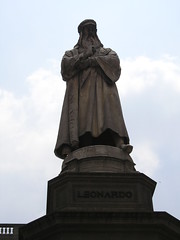
Leonardo da Vinci in Milan near La Scala Opera House, June 2004
Read Sherwin B. Nuland’s biography of da Vinci. It is part of the Penguin Lives series, which are short bios (< 200 pages) written by non-biographers. Nuland is a surgeon who teaches at Yale. While his biography focuses on da Vinci’s anatomical work, there are also some interesting comments about art and vision that relate to media.
Leonardo was one of the first to do drawings of actual cadavers. According to Nuland, most physicians of the time “regarded drawings as distractions from the text, using them only to support theoretical constructs about which the student was meant to learn by reading.” (p. 121). This bias continued for many centuries. Nuland quotes a review of the famous Gray’s Anatomy by Oliver Wendell Holmes that criticizes the text for its numerous drawings: “[L]et a student have good illustrations, and just so surely will he use them at the expense of the text” (p. 121). And this from 1859!
John Zuern’s contemporary answer to Holmes is found in his essay, Diagram, Dialogue, Dialectic: Visual Explanations and Visual Rhetoric in the Teaching of Literary Theory. According to Zuern, images are not just window dressing, something to accompany the more important text. Instead, “at their best, images that seek to help students understand ideas are able to perform two tasks: providing a clear representation of the concepts and offering a way of testing, challenging, critiquing that concept” (p. 70). He laments that most images in popular books about philosophy and literary theory “almost never exploit the capacity of the image to question the concept it is supposed to convey” (p. 70). Da Vinci understood, as his contemporaries did not, the importance of seeing as a way of supporting thinking and understanding:
“It is direct vision that differentiaties Leonardo’s studies from all that fell under the heading of Galenic. In order to answer his perennial question of why, he had first to understand how, which demanded a meticulous attention to accurate anatomic detail such as had never before seen so much as considered by any predecessor. To see clearly, to interpret objectively–these were the keys to solving nature’s riddles. His was the artist’s eye, but his also was the scientist’s curiosity and the scientist’s apperception that only by reducing a phenomenon to its component elements can it be fully understood. And only by knowing that minute particulars of structure can function even begin to be elucidated.” (p. 128). Nuland goes on for several pages singing the praises of Leonardo’s drawings an dillustrations.
Finally, Nuland describes Leonardo’s work with the eye. While the thought at the time was “that vision was perceived within the lens, he was able to satisfy himself that seeing is in fact the result of light being focused on the retina.” (p. 134). He did not, however, solve the riddle of upright images.
What’s the lesson here? There are at least two. First, as long as we continue to rely on printed textbooks as our primary texts, we must be thoughtful about the images we select and include as many as possible. In addition, we must recognize the power of the image to expand understanding rather than simply mimic the text. Second, we must seek out images to share with our students and discuss them openly with them, digging into the image to pull out is meaning. And, as one of my professors at WM does, we need to have them construct their own images and models that help them better understand their learning.
